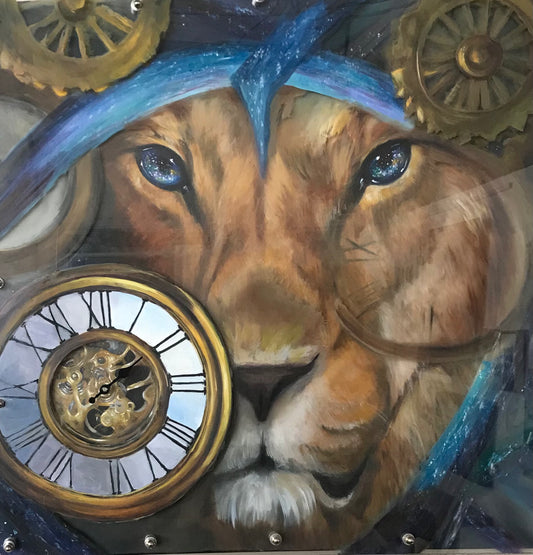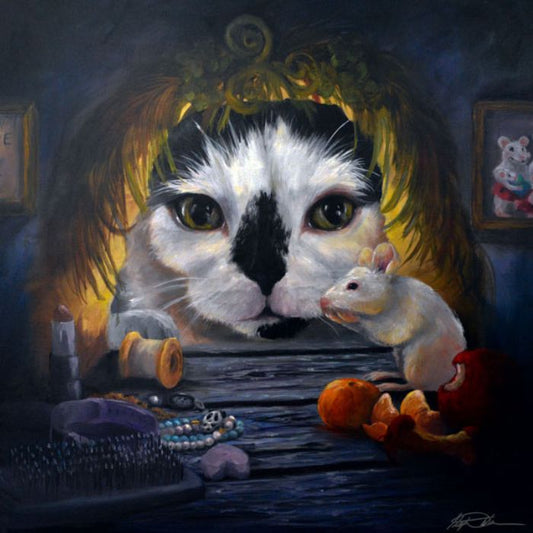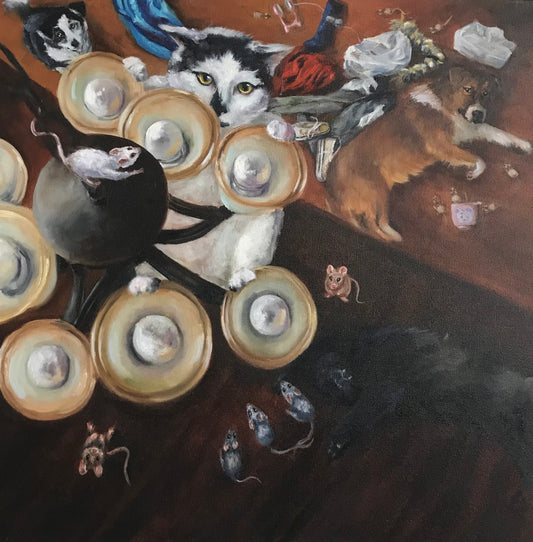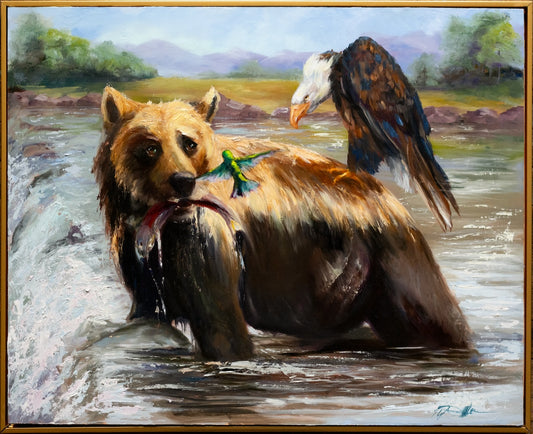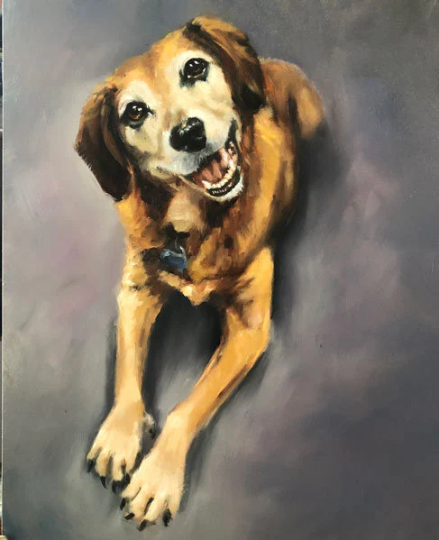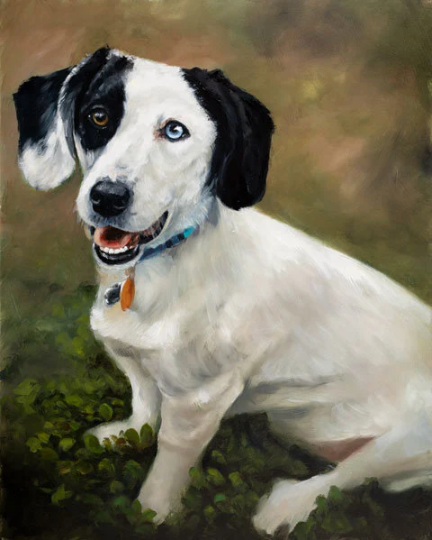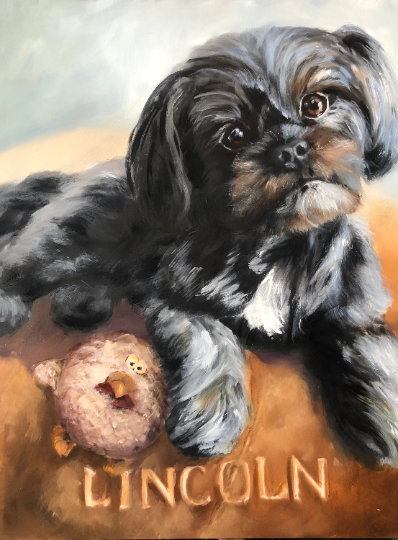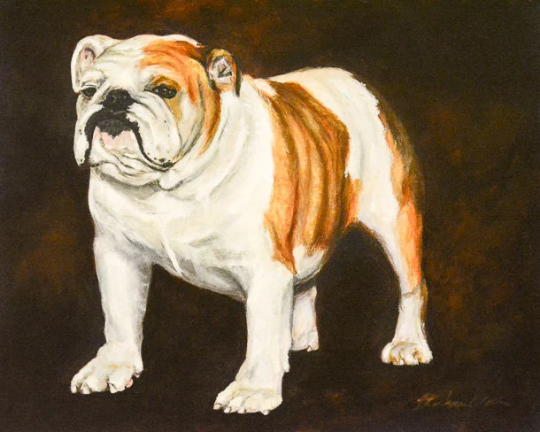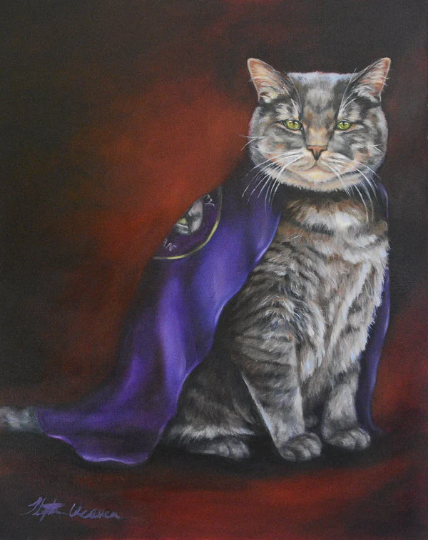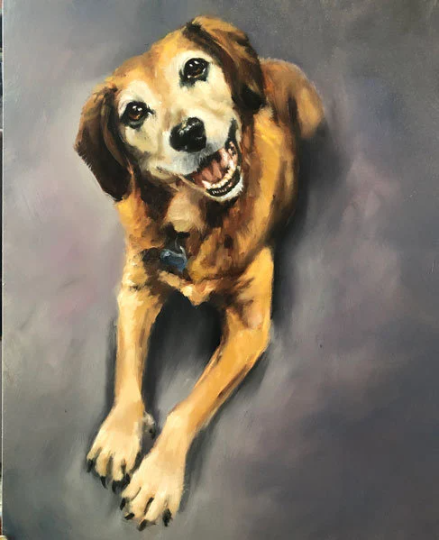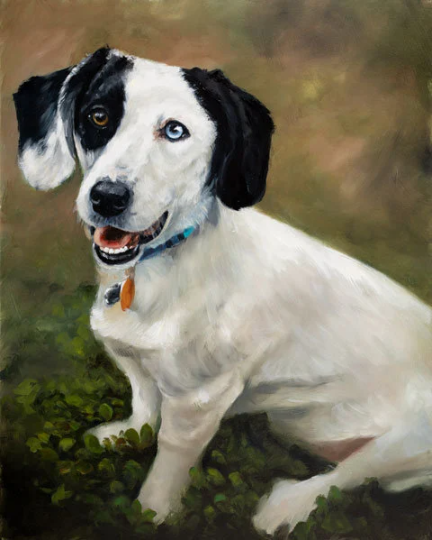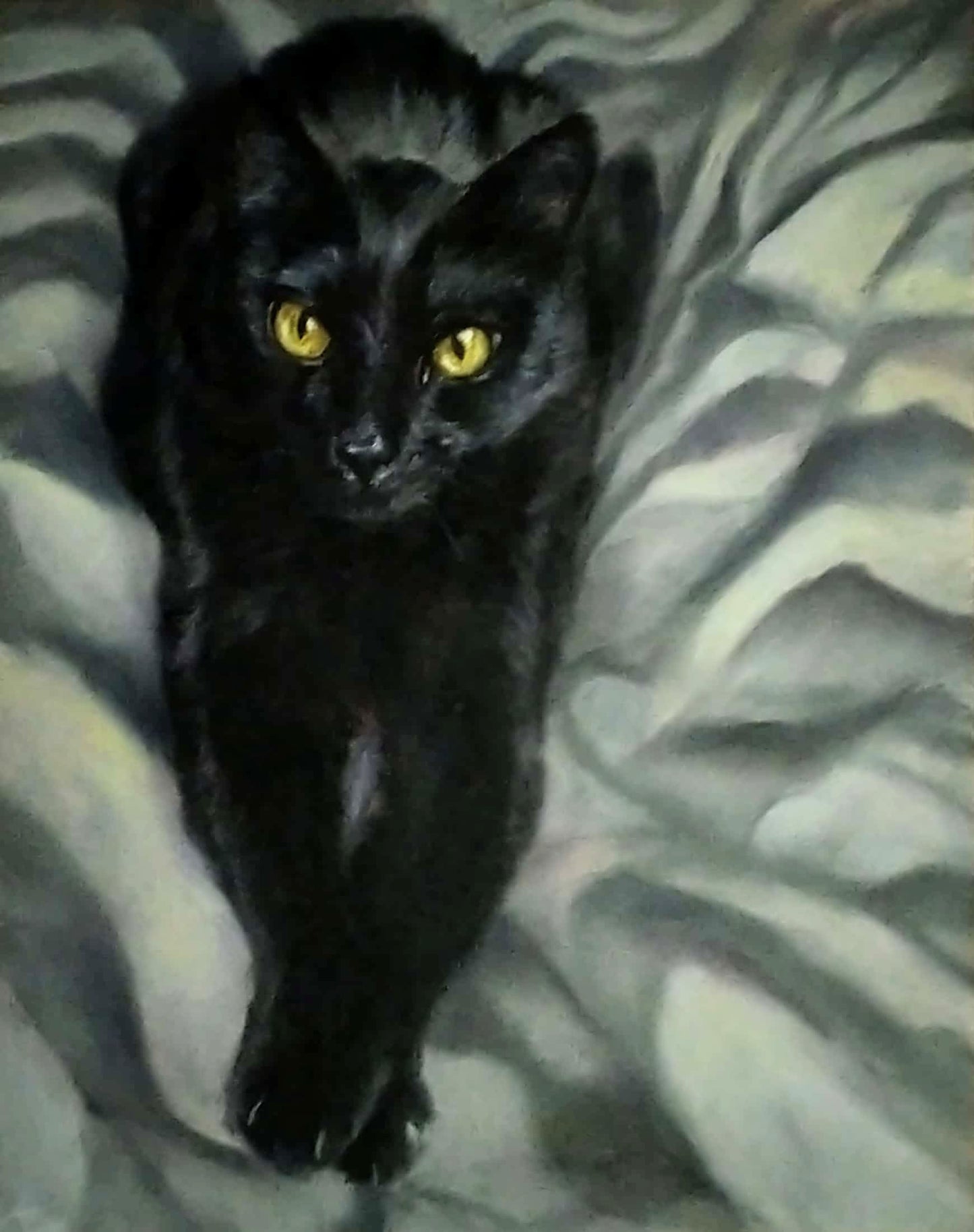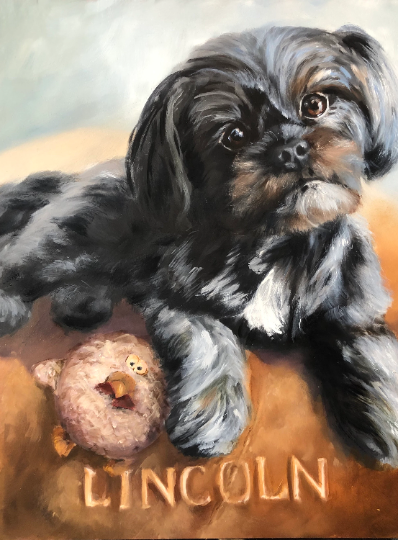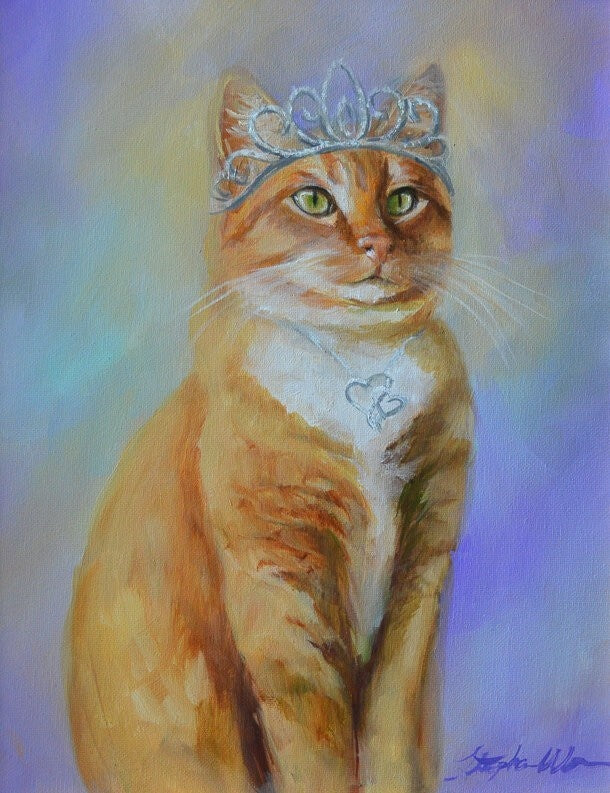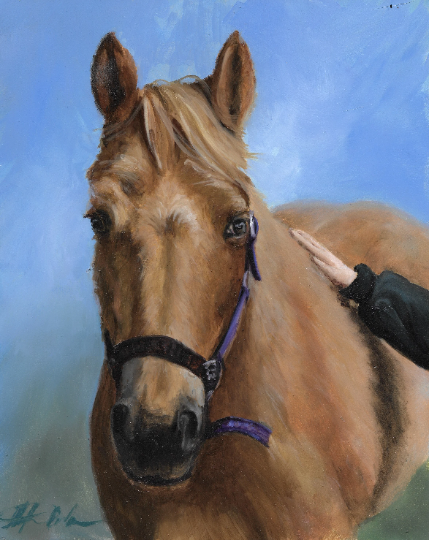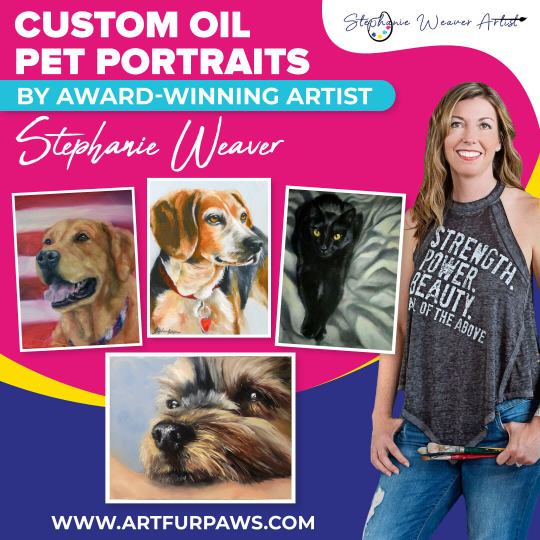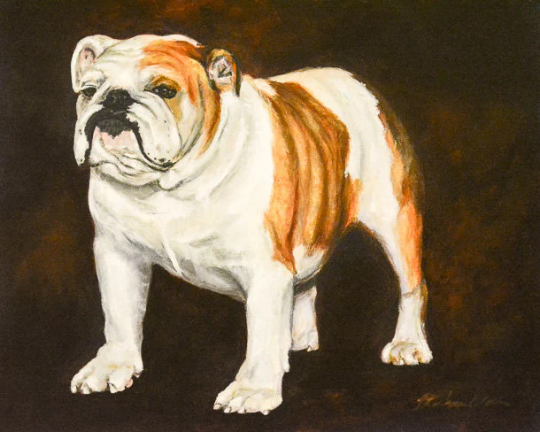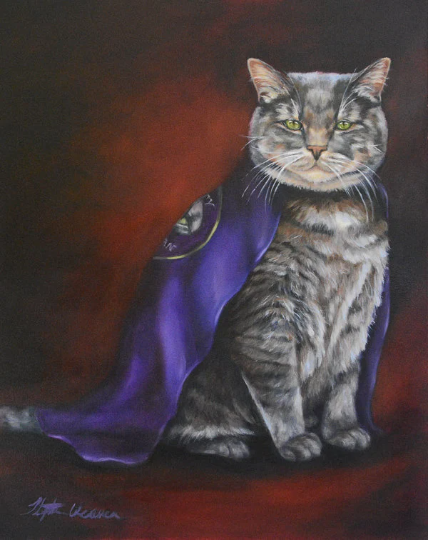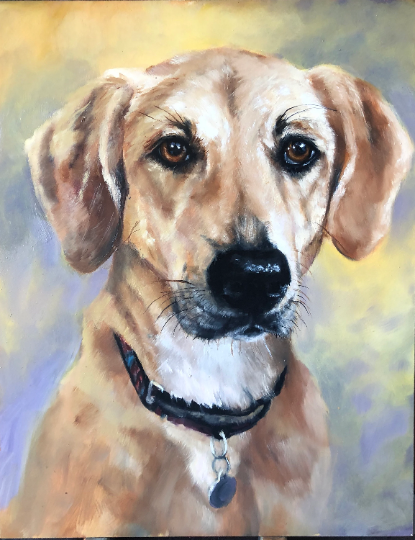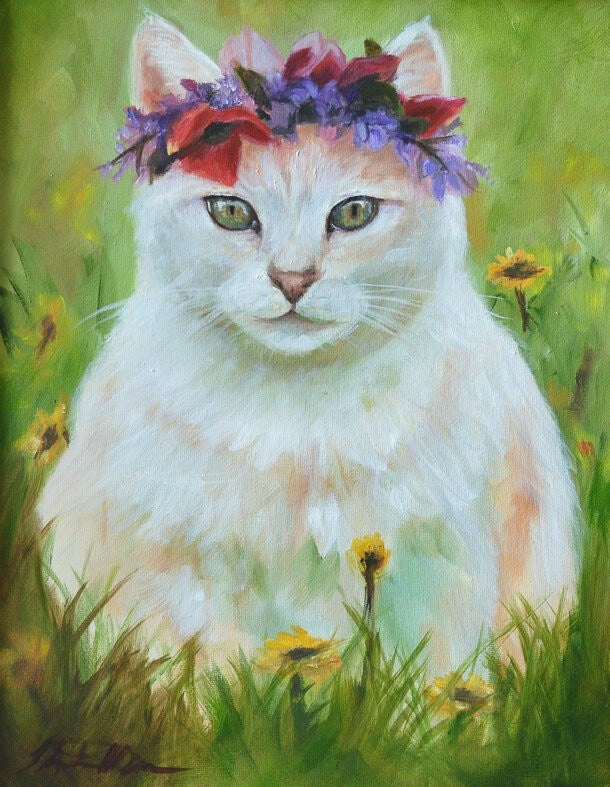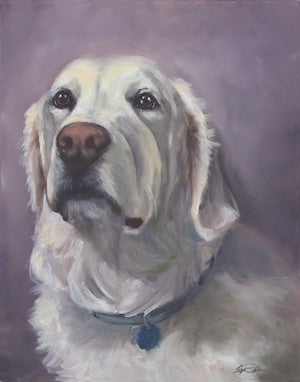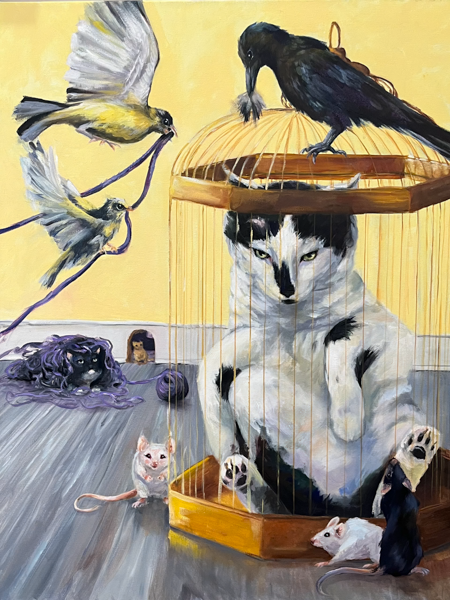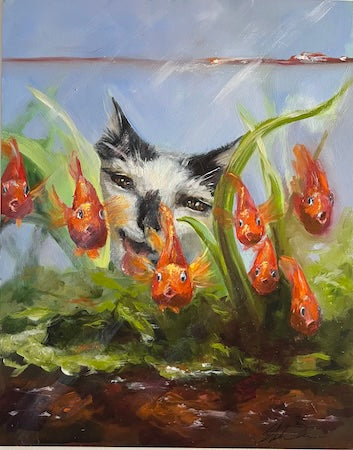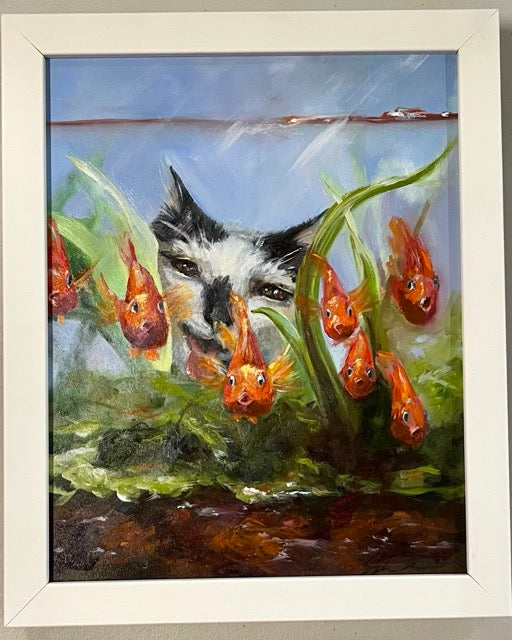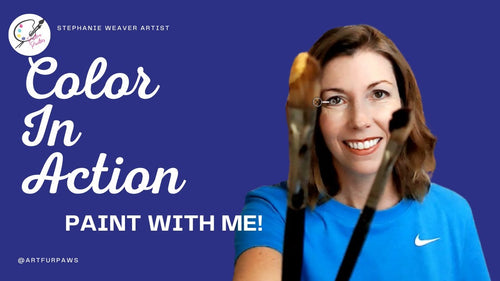Intro - Foster Failures Who Loved The Cat To a Healthy Weight
When we first fostered Cookie, she was a pregnant cat in dire need of care, struggling with severe underweight issues. Watching her become a vibrant, healthy cat was a journey filled with love and learning. We discovered that the right food and plenty of affection were essential to her recovery, transforming her from a fragile, malnourished kitty into a joyful, playful (and loud) companion. Cookie's presence not only inspired my art but also deepened my understanding of the importance of nutrition and comfort in a cat's life. As I paint Cookie’s playful adventures, I reflect on how nurturing her with the right diet and plenty of affection helped her thrive, just as we can help other cats find their health and happiness.
As a cat owner, it's normal to be concerned if your feline friend seems underweight and overweight. Whether you're dealing with an older cat, a malnourished kitty, or a picky eater, helping your cat achieve a healthy weight is important for their overall health. In this article, I'll cover the best ways to help a skinny or underweight cat gain weight, focusing on proper nutrition, medical conditions, and specific dietary needs.
Understanding Your Cat's Weight Loss
First things first—if your cat is losing weight unexpectedly, it's crucial to rule out underlying health issues. Medical conditions like kidney disease, inflammatory bowel disease, or intestinal parasites can affect a cat’s appetite and lead to weight loss. Senior cats, in particular, are more prone to weight-related health issues, so it’s essential to consult a vet to identify any medical reason for weight loss.
If your cat’s body condition score suggests they are too thin, addressing the root cause and adjusting their diet is the next step toward achieving a healthy weight.
What is a Body Condition Score (BCS)?
A Body Condition Score (BCS) is a system used to assess the body fat and overall physical condition of animals, including cats. It helps determine whether a cat is underweight, overweight, or at an ideal weight. The score typically ranges from 1 to 9, with 1 being emaciated and 9 being obese. A score of 5 is considered the ideal, indicating a healthy weight.
Here’s a general breakdown of the scoring system:
- 1/9: Emaciated – Ribs and backbone are highly visible, no fat covering, loss of muscle mass.
- 2/9: Very Thin – Easily felt ribs, visible spine and pelvic bones, minimal fat.
- 3/9: Thin – Slightly visible ribs, minimal fat covering, slightly defined waist.
- 4/9: Underweight – Ribs are palpable without excess fat, visible waist.
- 5/9: Ideal – Ribs are palpable with a slight fat covering, waist observed behind ribs.
- 6/9: Slightly Overweight – Ribs are harder to feel, slight abdominal fat pad, waist is slightly visible.
- 7/9: Overweight – Ribs are difficult to feel under heavy fat, visible fat deposits over the back, and a rounded abdomen.
- 8/9: Heavy Obese – Large fat deposits over ribs, lumbar area, and abdomen. No waistline.
- 9/9: Morbidly Obese – Extremely large fat deposits, massive abdomen, unable to see or feel bones.
How to Calculate a Cat's BCS
To determine your cat's BCS, follow these steps:
1. Feel the Ribs: Gently run your fingers along your cat’s ribs. In a cat with an ideal BCS, you should be able to feel the ribs with a slight layer of fat over them, but they shouldn’t be highly visible.
2. Examine the Waist: Look at your cat from above. There should be a slight indentation behind the ribs (waist). If the waist is too pronounced, the cat may be underweight, and if the waist is not visible at all, the cat may be overweight.
3. Check the Abdomen: Feel and observe the area just in front of the hind legs. In an ideal-weight cat, there should be a slight tuck-up (the abdomen should be higher than the chest when viewed from the side). Excess sagging or a hanging belly indicates overweight or obesity.
Why It BCS Matters
The BCS helps assess whether a cat is maintaining an appropriate weight and overall health. It's an important tool in identifying issues like underweight, obesity, or muscle mass loss, all of which can be related to health conditions such as intestinal parasites, dental problems, or digestive issues.
Keeping a close eye on your cat's BCS, especially as they age, is crucial in maintaining their overall health and quality of life. Regular assessments, combined with the right diet and veterinary guidance, can help keep your feline friend in peak condition.
How Many Calories Should My Cat Eat?
The number of calories a cat should consume each day depends on factors like age, weight, activity level and whether its been spayed or neutered. On average, adult cats typically need around 20-33 calories per pound of body weight daily. For example, according to the Honest Kitchen and Preventive Vet a 10-pound adult cat might need between 200-330 calories per day. Kittens and highly active cats may require more, while older or less active cats may need fewer calories.
The number of calories a cat should eat per day depends on several factors, including its age, weight, activity level, health status, and whether it's spayed or neutered. However, a general guideline can be provided based on a cat’s weight and life stage.
General Caloric Requirements for Cats
1. Indoor Adult Cat (at healthy weight):
- 20 calories per pound of body weight per day.
- Example: A 10-pound cat would need around 200 calories per day.
2. Outdoor Active Cat:
- 25–30 calories per pound of body weight per day.
- Example: A 10-pound active outdoor cat would need between 250–300 calories per day.
3. Kitten (up to 6 months):
- Requires double the calories of an adult cat relative to their weight, typically 40–50 calories per pound.
- Example: A 5-pound kitten may need 200–250 calories per day.
4. Senior Cat (over 7 years):
- Metabolism slows, but calorie needs vary based on health. Many senior cats will still need around 18–20 calories per pound, but if the cat is less active, slightly fewer calories might be needed.
- Example: A 10-pound senior cat may need around 180–200 calories per day.
5. Overweight or Obese Cats:
- It’s important to consult with a vet, but a typical recommendation is fewer calories, around 15–17 calories per pound of ideal body weight (not current weight) until they reach a healthier condition.
- Example: For a cat whose ideal weight is 10 pounds but currently weighs more, the target caloric intake should be around 150–170 calories per day.
Factors That Affect Caloric Needs
- Spayed/Neutered Cats: Tend to have lower energy needs, requiring around 20% fewer calories than intact cats.
- Pregnant/Nursing Cats: May need up to 2–4 times the normal caloric intake depending on the stage of pregnancy or lactation.
- Health Conditions: Cats with medical issues such as diabetes, thyroid problems, or kidney disease may have different caloric needs that require a vet’s guidance.
Monitoring Your Cat’s Weight
You can adjust your cat's caloric intake based on their body condition score (BCS), and if they are gaining or losing weight, you may need to modify their diet to fit their ideal weight.
Example Calculation:
- For a 10-pound indoor cat, the calculation would be:
10 lbs × 20 calories = 200 calories/day.
Special Considerations
If your cat is on a special diet or has picky eating habits, ensure they get the right mix of essential nutrients. Monitoring their meal time, appetite, and checking the calorie content of their food can help them maintain a healthy weight.
Consulting with your vet is the best course of action if your cat has unexplained weight loss or health issues affecting its caloric needs.
Best Foods for Weight Gain in Cats
When it comes to helping your cat gain weight, feeding the best food with a balanced nutritional profile is key. Cats are obligate carnivores, meaning they need animal proteins and essential nutrients and amino acids to maintain their muscle mass and overall health.
- Wet food: This is often the best option for encouraging weight gain, especially for older felines or cats with dental problems or who are having trouble smelling due to sinus infections. Wet food is easier to eat and more palatable for picky cats. It's also packed with moisture, which can support digestive health and often have intense smells that encourage their appetite.
- Dry food: While dry cat food tends to have a higher calorie content, it might not be suitable for every cat. Cats with dental issues or older cats may struggle with the crunchy texture, so a combination of wet and dry food might be a good idea.
- High-calorie cat food: Look for food specifically formulated for weight-gain diets or senior cat gain weight plans. These are usually packed with fatty acids and necessary calories to support healthy weight gain.
Best Wet Food Options
When choosing the best wet food options for your cat, particularly for those who need to gain weight or have specific dietary needs, it’s important to look for brands that are high in animal protein, provide a balanced amount of fatty acids, and offer essential amino acids like taurine. Wet food is often more palatable for cats and easier to digest, making it a good choice for older felines, picky eaters, or cats with dental problems. Here are some of the best wet food options to consider:
1. Hill's Science Diet Adult Urgent Care A/D Wet Food
- Best for: Cats recovering from illness or weight loss
Source: Hill's Science Diet
- Why it’s good: This vet-recommended formula is designed for malnourished kitties or those who are underweight due to medical conditions. It's high in calories, protein, and fatty acids, helping your cat regain weight and muscle mass.
- Special features: Easily digestible and loaded with nutrients to support overall health.
2. Royal Canin Veterinary Diet Recovery RS Wet Food
- Best for: Cats recovering from illness, surgery, or underweight cats
Source: Royal Canin
- Why it’s good: This option is specifically made for underweight cats or those recovering from digestive issues. It’s packed with high-calorie content, and the soft texture makes it easy for cats with dental issues or reduced appetite to consume.
- Special features: It contains essential nutrients and is easy on the digestive system.
3. Wellness CORE Grain-Free Canned Cat Food
- Best for: Healthy weight gain with natural ingredients
Source: Wellness Pet Food
- Why it’s good: This high-protein, grain-free wet food is great for helping a skinny cat gain healthy weight. It contains real animal proteins like chicken and turkey, along with omega fatty acids for a shiny coat and healthy skin.
- Special features: No fillers, artificial additives, or grains. It’s a premium option for cats with food allergies or sensitive stomachs.
4. Blue Buffalo Wilderness High Protein Grain-Free Wet Food
- Best for: Active or underweight cats needing extra calories
Source: Blue Buffalo
- Why it’s good: Packed with animal proteins from chicken, salmon, and turkey, this wet food is designed for cats who need to gain muscle mass. It's grain-free, making it suitable for cats with food sensitivities.
- Special features: Includes a mix of essential nutrients and amino acids to support muscle growth and overall health.
5. Purina Pro Plan Veterinary Diets DM Dietetic Management Wet Food
- Best for: Cats with diabetes or weight issues
Source: Purina Pro Plan
- Why it’s good: This high-protein formula is great for picky cats or those with specific dietary needs due to diabetes. It helps with healthy weight gain without causing an excessive spike in blood sugar.
- Special features: Contains high levels of protein while being low in carbohydrates, ideal for managing feline health issues like diabetes.
6. Tiki Cat Aloha Friends Wet Cat Food
- Best for: Cats needing high-quality protein in small meals
Source: Tiki Cat
- Why it’s good: This option contains real fish or chicken in broth, offering a high-protein, low-carbohydrate formula. It’s especially appealing for picky eaters due to its high moisture content and tasty flavors.
- Special features: Grain-free and suitable for cats with food allergies or digestive issues.
7. Weruva Cats in the Kitchen Grain-Free Canned Food
- Best for: Cats with food allergies or needing weight gain
Source: Weruva
- Why it’s good: Weruva’s wet food is made with high-quality, natural ingredients and is rich in animal protein. The grain-free recipe helps maintain healthy weight and muscle mass while supporting digestive health.
- Special features: High moisture content and palatable for picky eaters or cats with sensitive stomachs.
8. Instinct Original Grain-Free Pâté Wet Cat Food
- Best for: Cats needing a boost in muscle mass and weight
Source: Instinct
- Why it’s good: Made with real meat like chicken, turkey, and duck, this wet food is great for cats needing extra calories. It also includes omega fatty acids for a healthy coat and skin.
- Special features: Contains no grain, soy, or fillers, making it suitable for cats with food sensitivities.
9. Fancy Feast Gourmet Wet Cat Food Classic Pâté
- Best for: Picky cats who need to gain weight
Source: Fancy Feast
- Why it’s good: Though not as high-end as some premium brands, Fancy Feast’s classic pâté options are affordable, high in protein, and highly palatable for picky eaters. It’s easy to find and well-loved by many cats, making it a good option for those struggling to eat.
- Special features: Budget-friendly and available in many flavors.
10. Natural Balance Ultra Premium Wet Cat Food
- Best for: Balanced, nutrient-rich wet food
Source: Natural Balance
- Why it’s good: This brand offers balanced nutrition with a focus on real, high-quality ingredients. It’s ideal for supporting weight gain in cats that need extra portions of food or a boost in their caloric intake.
- Special features: High in protein and available in a variety of flavors for picky cats.
Choosing the right wet food for your underweight or senior cat is essential to helping them gain weight in a healthy way. Always look for food rich in animal proteins, high in calories, and free from fillers or artificial ingredients. Additionally, keeping your cat comfortable and stress-free during mealtime (such as petting them while they eat) can make a big difference in encouraging better eating habits, especially for picky eaters or older felines. Consult with your vet to ensure you’re selecting the best food for your cat’s specific needs and health conditions.
Beyond Food - Cat's Behaviors Can Influence Their Appetite
When it comes to feeding your cat, food alone isn’t the only factor that influences their appetite. For some cats, behaviors like being petted while they eat can provide comfort and encourage them to eat more, especially if they're feeling anxious or picky. Adding variety to their diet, such as rotating flavors or textures, can also help stimulate a reluctant eater. Older cats require special consideration due to age-related changes in appetite and health, making it essential to monitor their weight regularly and adjust their diet accordingly. The role of supplements in a weight-gain diet can be valuable for cats needing extra nutrients, but it’s important to avoid overfeeding and ensure you’re providing a balanced approach that supports overall health. Tracking your cat’s behavior, weight, and health ensures they get the care they need without the risk of obesity.
Adding Variety to Boost Appetite
For picky cats or those with a diminished appetite, consider introducing new food slowly. Small meals throughout the day can encourage your cat to eat more without overwhelming their digestive system.
Some owners have found success incorporating small amounts of human food like egg whites or cottage cheese into their cat’s diet. These high-protein foods provide essential nutrients and can be a good option for cats who need an extra boost in calories. However, always ensure that human foods are safe for cats, and consult your vet before making changes to your cat’s diet.
Some Cats Like to Be Petted While They Eat
Interestingly, some cats are comforted by being petted while they eat. If your cat enjoys this, you may notice that they eat better or show more enthusiasm during meal times when you’re around to offer affection. This behavior often provides reassurance, especially for picky eaters or older cats who might be dealing with dental problems or a decreased appetite. If your cat seems to eat more when you're gently stroking them, it's a good idea to make this part of their mealtime routine. It can reduce stress and encourage better eating habits, especially if your cat tends to be more social.
Special Considerations for Older Cats
As cats enter their golden years, their nutritional needs change. Senior felines may need a specific diet that supports their digestive health, especially if they are dealing with age-related medical conditions. Picky eaters may also need foods with more flavor or softer textures to stimulate their appetite. Offering frequent meals and small portions can help older cats maintain a consistent caloric intake.
The Role of Supplements in a Weight-Gain Diet
Supplements like fatty acids and vitamins can help older cats maintain muscle mass while gaining weight. Cats with food allergies or sensitive stomachs may need a specific nutrient or supplement to ensure they’re absorbing all the nutrients from their food.
Monitoring Your Cat’s Weight and Health
Regular monitoring of your cat’s weight and keeping an eye on the food bowl are essential. Make sure your cat is not just putting on fat but also building muscle mass. Track their body condition score to assess if they are reaching their cat’s ideal weight.
Additionally, don’t forget to monitor the litter box for signs of any digestive issues, which could indicate that the new diet isn't agreeing with your cat.
Avoid Overfeeding
While it’s important to help your skinny cat gain weight, be cautious not to go overboard. Obese cats face their own health risks, including digestive system problems and joint pain. Feeding your cat high fat foods or extra portions of food might seem like an easy way to help them gain weight, but the best course of action is to provide balanced meals that support healthy weight gain.
Conclusion
Helping a malnourished kitty or an elderly cat regain a healthy weight requires patience and the right mix of diet, supplements, and veterinary advice. By choosing the best diet for your cat’s age, health status, and caloric intake needs, you can ensure they gain weight in a healthy way. Remember, every cat is different, so what works for one feline might not be suitable for another. Consult with your vet to develop a tailored plan that ensures your furry friend stays happy and healthy.
Artistic Process: From Cat Inspiration to Oil Painting
Choosing a Cat as a Subject and the Cat's Story Line
I've always loved animals and their honest expressions. but it wasn't until the pandemic that I was not obscured by the thoughts of reality...it was fun letting my imagination run wild. I learned what I was doing was call "anthropomorphism". This is when human characteristics, behaviors, or emotions are attributed to animals, objects, or other non-human entities. In art and storytelling, anthropomorphism is often used to create relatable or whimsical depictions of animals acting like humans—such as dressing them up, having them speak, or making them engage in human-like activities.
In my paintings of our cat Cookie, anthropomorphism is subtly at play, as Cookie interacts with other animals or objects in a way that reflects human-like curiosity and emotion, giving her adventures a playful and imaginative twist.
In the rest of this article I'm going to share with you a bit of the process behind each painting.
"Are you protected or trapped?" original oil painting 30" x 30"
THE MEANING BEHIND THIS SCENE
“Are You Protected or Trapped?” In this captivating artwork, our plump and imposing cat Cookie (also affectionally known as 'Fat Lightening' for her quick bursts of energy) stands before the entrance of a tiny mouse's house. The feline's gaze, simultaneously curious and predatory, raises an essential question: Are we protected in our havens or inadvertently trapped by our circumstances?
Inside the mouse's house there are several details that I'd love to call out:
- The artwork includes trinkets from my daughter's room that the mouse has collected
- There are symbols for luck over the archway, like Rosemary, Trinity Symbol and Four leaf clovers.
- You'll also notice off to the side of the entrance are the makings of a family portrait and on the other a "beware of cat" sign.
"Who is ruling who?" original oil painting 24x24"

THE MEANING BEHIND THIS SCENE
“Who is ruling who?” artwork that captures a moment of chaos and upheaval as the balance of power shifts dramatically. In this dynamic scene, our fat cat Cookie finds herself in a precarious situation, hanging desperately from a chandelier. Below, a swarm of determined mice scurry about, seizing the opportunity to take control and reclaim their freedoms from the oppressive feline and her accomplices.
"Who is Ruling Who?" tells a story of revolt and liberation, illustrating the idea that sometimes the seemingly powerless can unite and challenge those who have held sway for too long. It's a reminder that even in the face of chaos and confusion, the pursuit of freedom and justice can bring about a more equitable world. This artwork sparks contemplation on the dynamics of power and the potential for change when the oppressed rise together to take back control.
When I finished this painting my daughter teared up and said "poor Cookie, she looks so scared! What is she going to do?" (Cookie is her cat that she adores and showers attention and affection).
What I see in this story is the question "who started this and goaded the cat to get from such a precarious position - did she do it herself or does the dog in the upper left look overly excited about the events? (the dog is Sophie, border collie-aussie mix and the other dog that looks confused is Bacon.)
What do you see when you look at this piece?
THE MAKING OF THIS PIECE
This one was fun one for reference image creation. My daughter held Cookie up into the air so I could get a picture of her looking up at me with a somewhat helpless look. I then went around the house, climbing on top of furniture to take reference pictures of our other cats and dogs (our 2 cats - Cookie and Brownie, and our 2 dogs Sophie and Bacon - we don't have any mice :) ).
Once I had the reference images, I quickly sketched and just started painting!
"The Little Guys Win!!" original oil painting 18" x 24"
THE MEANING BEHIND THIS SCENE
This painting visually narrates a triumphant tale of the underdogs prevailing against all odds. In this vibrant scene, a once-arrogant fat cat now finds itself trapped within the confines of a bird cage. The fat cat is not ashamed, instead, the defeated cat’s look is plagued with anger boiling under the surface, showing that power and control is an obsession and fear is the means in which it is obtained. Meanwhile, a jubilant congregation of mice and birds surrounds the cage, celebrating their unexpected and hard-fought victory.
"The Little Guys Win!" encapsulates the enduring message that justice and freedom can prevail, even when it seems impossible, but it will not be gifted by the oppressors. It serves as an inspiring reminder that when individuals from different backgrounds come together to challenge inequality and oppression, they can achieve remarkable victories. The artwork embodies the joy of triumph over adversity and the belief that a united front can bring about positive change.
THE MAKING OF THIS PIECE
This is the 3rd painting I did of Cookie. At the onset, I didn't know I wanted to paint Cookie, all I knew is I wanted something to be in a cage and then I came across this reference image my daughter took of Cookie cleaning herself.

And I thought PERFECT. She has that look of being caught, indignation and F off at the same time!
The rest of the imagery I grabbed cutouts from magazines or catalogs to use as reference images and then began researching the size of the bird in comparison to a cat and/or mouse to ensure that it was accurate size-wise.
A quick sketch later and I was ready to paint!
The painting process itself is one that builds layer upon layer to capture the glint in the eyes of all the animals and the sparkle in the cage and reflection of the cage on the wood floor.
"Cookie's Christmas" Original Oil Painting 10" x 10"
THE MEANING BEHIND THIS SCENE
The painting captures a moment of stillness before action, with a playful undertone reflecting Cookie’s inquisitive nature. This artwork of Cookie, sitting with a gift box and a small mouse peeking out, suggests a playful and whimsical interpretation of curiosity and surprise. The colorful box and shiny ribbon, alongside the presence of a tiny mouse, symbolizes a combination of innocence and adventure—a cat’s natural instincts of curiosity paired with the playful excitement of discovery.
The use of soft light and vibrant colors enhances the magical, almost anthropomorphic feel of the scene, making Cookie not just a cat but a character with emotions and thoughts of her own.
THE MAKING OF THIS PIECE
It all started with this image of Cookie and Brownie under our Christmas Tree and then the concept solidified with another reference image of Cookie chewing on a fake plant.


This painting was pretty clear in my head so I skipped the sketch and went straight to painting.
"Curiosity Beneath the Surface" Original Oil Painting 8x10"
THE MEANING BEHIND THIS SCENE
The artwork features Cookie dreamily licking the glass on the fish tang filled with vibrant orange fish.
This piece captures a moment of curiosity and wonder. It encourages a deeper appreciation of the natural world's beauty and the playful intersection of the familiar and the extraordinary. Keep embracing this imaginative spirit, as it brings a unique and joyful perspective to your work.
THE MAKING OF THIS PIECE

What is the best way to have any animal participate in a photo session?
Food!
In this case, I had clear plexiglass available and a can of tuna. And voila, so many ideas are born!
I admit, it did take some patience because the dogs and cats have never licked from plexiglass before, but once they got started the ideas of how can paint them went on and on. Now it is just a matter of time before the next Cookie adventure is captured in an oil painting.
Final Thoughts on Cats and Art
Part of being an artist is about observing behaviors. Cats are often a finicky bunch and misunderstood, and to me they are more authentic (if not slightly extreme) representations of human behavior than any other animal...it is just a matter of learning their queues. The behaviors explored in "Why Does My Cat Bite Then Lick Me?" are vividly brought to life in Cookie's whimsical adventures throughout my artwork.
By viewing Cookie’s adventures, we can embrace and appreciate the whimsical, affectionate, and sometimes puzzling behaviors of our own cats, we can better understand the subtle cues and instincts that drive our furry companions, reminding us that their actions—whether they eat too little or too much—are all part of the intricate language they use to communicate with us.
For cat parents who are dedicated to ensuring their cat’s health and happiness, paying attention to meal times, food choices, and regular vet visits will make all the difference.





